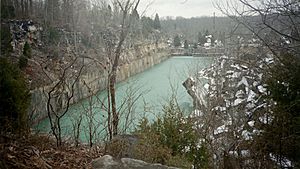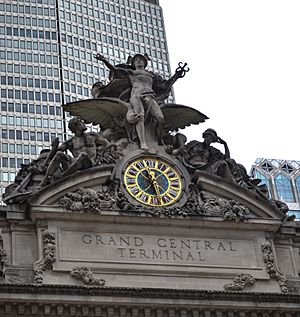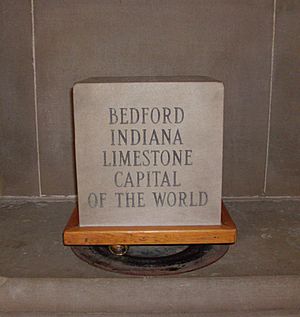Indiana Limestone facts for kids
Indiana limestone is a special type of rock found mostly in south-central Indiana, USA. It's also known as Bedford limestone because a lot of it comes from quarries near the city of Bedford. This rock has been used for a very long time to build important buildings, especially big public ones.
Indiana limestone is a type of limestone, which is a rock made mostly of calcium carbonate. It formed over millions of years from the tiny shells and skeletons of sea creatures. These creatures lived in a shallow inland sea that once covered much of what is now the Midwestern United States. When they died, their remains settled at the bottom of the sea and slowly turned into this strong rock.
Contents
History of Indiana Limestone

Long ago, Native Americans were the first to find limestone in Indiana. Later, American settlers also started using this rock. They used it for things like window frames, door frames, and even memorials in their towns.
The first quarry for Indiana limestone opened in 1827. By 1929, quarries in Indiana were producing huge amounts of stone. The growth of railroads created a big demand for limestone. It was needed to build bridges and tunnels across the country.
In the late 1800s and early 1900s, many American buildings used detailed limestone designs. As building styles changed, the demand for limestone went down. However, in 1971, Indiana limestone was officially named the state stone of Indiana.
After the 1973 oil crisis, the cost of other building materials went up a lot. This made Indiana limestone popular again because it was a good, energy-efficient choice.
Famous Buildings Made with Indiana Limestone
Indiana limestone has been used in many important buildings, both in Indiana and across the United States. It's known for its beautiful look and strength.
Local Buildings in Indiana
Many official buildings in Indiana are made with this local stone. For example, the Indiana State Capitol building and many monuments in Downtown Indianapolis use Indiana limestone. The Indiana Government Center and most of the state's 92 courthouses also feature this stone.
A large part of Indiana University, Bloomington was built using limestone. Even churches like St. Augustine's Episcopal Church in Gary and the Saint Sava Serbian Orthodox Church in Merrillville use it. The Saint Sava church even won an award for its design!
National Landmarks and Universities
Across the United States, Indiana limestone has been used for many famous buildings. It's often seen on the outside of homes, businesses, and government buildings.

Some very well-known buildings that feature Indiana limestone include the Washington National Cathedral, the Biltmore Estate, and the Empire State Building. Even the Pentagon and the Hotel Pennsylvania use it. About 35 out of the 50 state capitol buildings in the U.S. are made with Indiana limestone.
After the Great Chicago Fire in 1871, a lot of Chicago was rebuilt using this stone. The huge sculpture called Glory of Commerce on top of Grand Central Terminal in New York City is also made from Indiana limestone. This sculpture, created by Jules-Félix Coutan, was once considered the largest in the world!
The original buildings of Rockefeller Center from the 1930s also used limestone from Bedford. When the Pentagon was rebuilt after the attack on September 11, 2001, about 15,000 cubic feet of Indiana limestone was used. The new Yankee Stadium in New York, which opened in 2009, also has a lot of Indiana limestone on its outside.
Many university campuses love Indiana limestone for their buildings. The University of Chicago's campus, with its Neo-Gothic style, is almost entirely built from Bedford limestone. Washington University in St. Louis and Michigan State University also have many buildings made with it. The Cathedral of Learning at the University of Pittsburgh, a very tall Neo-Gothic skyscraper, is covered in Indiana limestone.
Even though it's a strong stone, acid rain can cause damage over time. Because of this, Indiana limestone is not used as often in new monuments today as it was in the past.
See also
 In Spanish: Piedra caliza de Indiana para niños
In Spanish: Piedra caliza de Indiana para niños


